Museum
Published in Issue 6 (Nov/Dec 2007), Reviews, Volume 15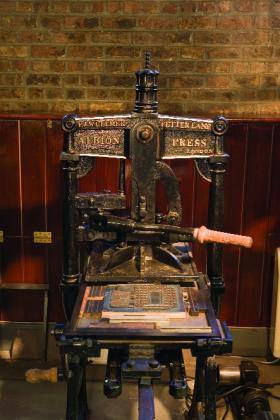
An Albion hand printing press — a British copy of the Columbia press that revolutionised printing in the early nineteenth-century.
National Print Museum
Músaem Náisiúnta Cló
Garrison Chapel, Beggars Bush, Haddington Road, Dublin 4
+353 (1) 6603770, npmuseum@iol.ie, www.nationalprintmuseum.ie
Mon.–Fri. 9am–5pm, Sat. & Sun. 2–5pm
Closed bank holiday weekends
by Tony Canavan
The National Print Museum is located on a very historic site. A British army barracks was built here in the eighteenth century and many old military buildings remain. It was converted for civilian use in the 1960s and now houses the Labour Court, the Geological Survey of Ireland, government offices and the Museum of Labour History as well as the National Print Museum, which was opened in 1996.
You enter the barracks through an ornamental arch. Once beyond the high wall, the atmosphere is very much a civilian one as a large office block dominates the lower buildings that remain from its days as a barracks. Ahead of you is a classic Georgian house that is now home to the Museum of Labour History. The National Print Museum is in what was once the barrack’s chapel, behind the modern offices and terraces of old barrack housing. Surprisingly, you enter through a modern glass conservatory, which is the museum café. Glass doors from it open onto a small shop and reception area.
The visitor is greeted by a large hall with a balcony running around it. The first impression is of a clutter of machines that appear to be in no particular order, all dominated by a large painted banner proclaiming ‘Bookbinders Consolidated Union’, whose motto was ‘Bind Might With Right’. Visits to the museum are conducted through guided tours that begin upstairs on the balcony (also used to show temporary exhibitions) with a 15-minute video on the history of the site and what is in the museum. This video is really essential as it explains not only that all the machines are in working order but
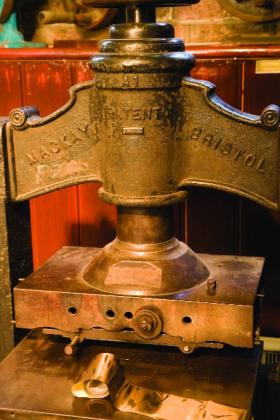
A special press for printing decorative gold leaf onto book covers, invitations, etc..
what their names are and what they do. You begin to realise that the machines downstairs are not disorganised but arranged according to function and age. You learn, too, the vocabulary of printing and the significance of words like stone, chase, furniture, forme, planer, and so on.
The video brings home just how much printing has always been part of our lives, since posters, newspapers, books, tickets, menus etc. all have to be printed. It brings home too how much things have changed in the last decade. Basically printing was the same for 500 years since Gutenberg invented the press in 1440. The machines grew more sophisticated and could perform more complex tasks over the centuries, but they still involved moulding metal into the shapes of letters, covering them in ink and then pressing them onto sheets of paper. It is so different now, as all printing exists virtually on a computer screen, where it can be proofread and redesigned before even getting near a sheet of paper.
After the video, the guide—in our case a charming German called Karina—takes the group downstairs for a walk among the machines. We start in the type-shop, a recreation of one from the 1940s but it could be from any time in the previous 200 years. The tour then wends its way through the various presses and other machines, such as the three carriage pen ruler, which was used to draw straight lines on exercise books, ledgers and so on. The oldest press is the Columbian or Eagle press, which was invented in America and revolutionised mass printing in the early nineteenth century. This is a beautiful machine that reminds us how in times past things were designed to
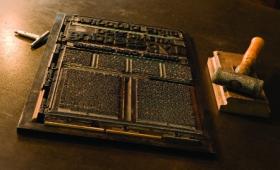
A sample block ready to go into a printing press illustrating different examples of type.
be not just functional but also pleasing to the eye. It is decorated with a large American eagle and gilded patterns. With its system of levers and weights it could be operated with little effort and produced many sheets of print in a short time.
The Industrial Revolution saw powered presses that worked even faster. One on display is the Wharfdale, built in Yorkshire, England. It was on such a press that the 1916 Proclamation was printed, although this one originally belonged to the Nenagh Guardian. Both the mechanised and manual typesetters and presses operated with hot metal. This literally meant that metal—lead in the old days—was kept liquid hot and poured into moulds to produce letters as needed. Even with more modern machines, the hot metal was kept alongside and automatically poured into moulds. It was the lowliest apprentice’s job, usually a young boy, to collect the discarded typeset and bring it back to a cauldron where he melted it down for use again. The tour ends at such a ‘hell box’, as it was called, and is a reminder of how much our ideas on health and safety have moved on.
I left this tour enthused by our guide and impressed by the workings of the machinery, yet I felt, as did others, that there could have been more on printing in Ireland. If it were simply a print museum then the concentration on machinery alone would be acceptable, but it is the National Print Museum and I had hoped for more on Ireland. Yes, we did learn about the 1916 Proclamation and that de Valera bought the machinery for the Irish Press in the USA, and we did see the forme for the last issue of the Sunday Independent using hot metal, but I had hoped to learn when printing first began in Ireland, what was the first book printed, what was the first newspaper, how did printing impact on Irish society and politics and so on. While this museum is interesting, it is so more from a technical than a historical perspective. Perhaps some of the balcony space could be given over to exhibits related to answering the kind of queries raised above.
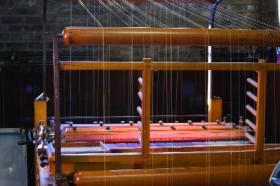
A special machine for priniting straight lines onto exercise books, ledgers, etc..
As a footnote to this review, let me say that I went to the National Print Museum with the Friends of the Chester Beatty Library. The afternoon at Beggars Bush also included a tour of the stores and workshops of the Natural History Museum
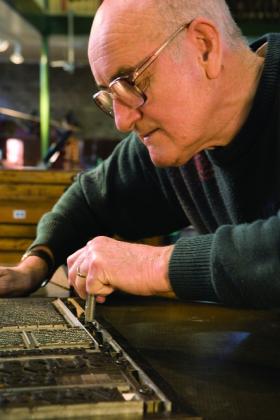
A typesetter at work — an ancient skill practised for hundreds of years ever since Gutenberg invented the printing press.
(which is temporarily closed), which gave us a fascinating glimpse behind the scenes at that museum and an opportunity to see items from its geological collection which have not been on public view since the 1960s. I make this point to show that one of the benefits of joining any society, whether the friends of a museum or a local history society, is that you frequently have the opportunity to visit places that are not open to the public and get rare insights into the workings of our heritage institutions. So if you are not in a society already, I recommend joining one—or more—right away.
Tony Canavan is a former Museum Officer of Newry and Mourne District Council.
















